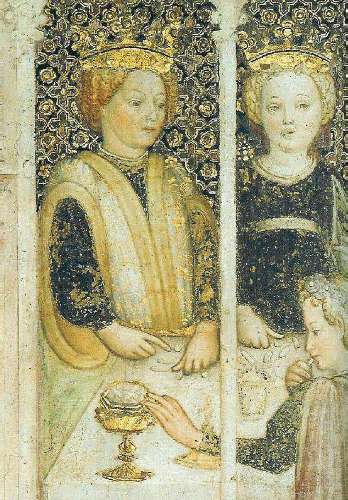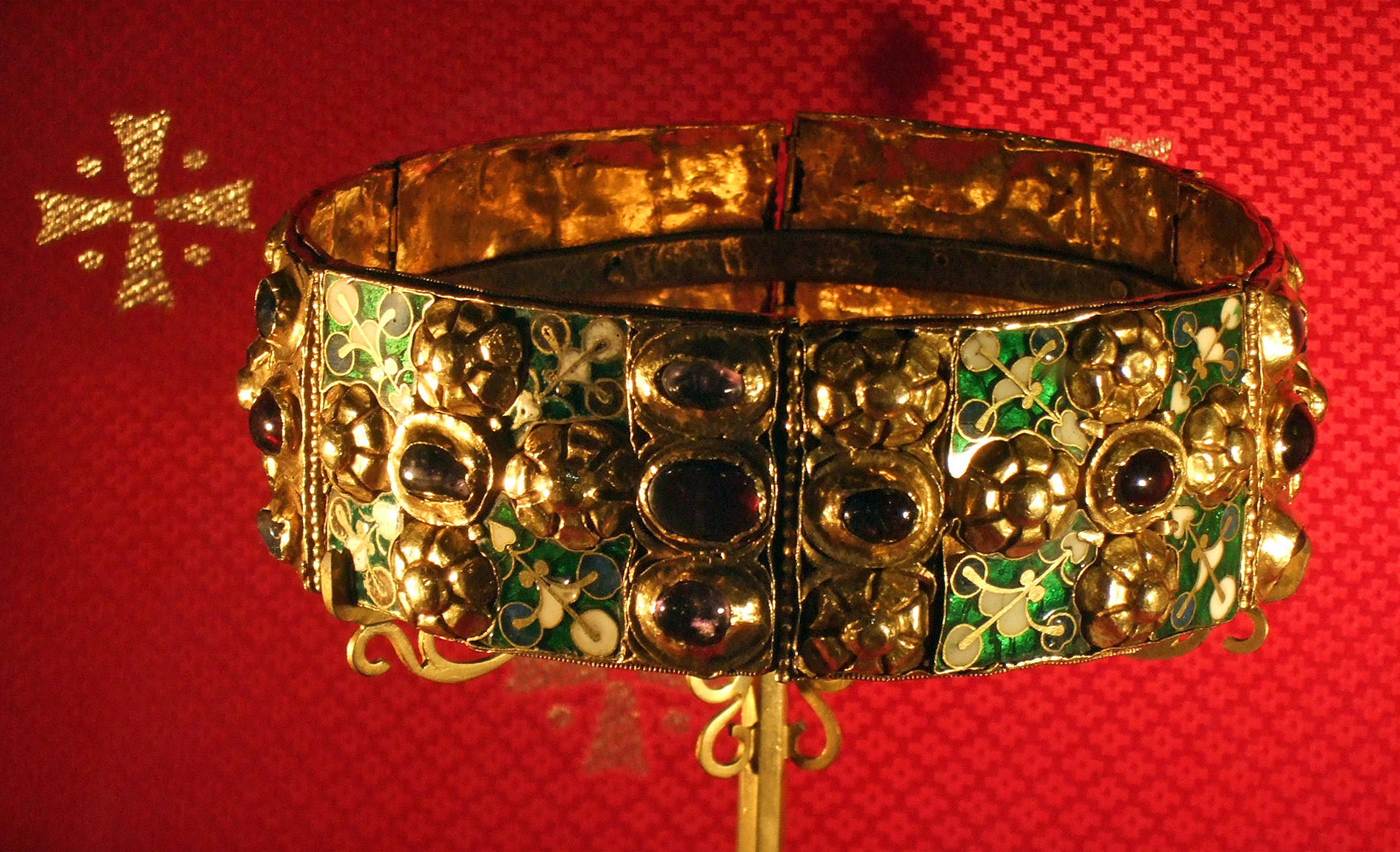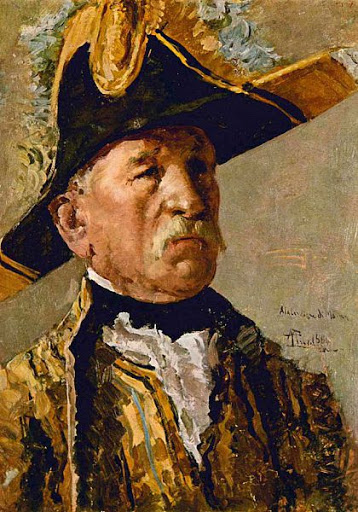Monza Cathedral on:
[Wikipedia]
[Google]
[Amazon]
The Duomo of Monza (), often known in English as Monza Cathedral, is the main religious building of
Basilica di S. Giovanni Battista. According to the legend she had made a vow to build a church dedicated to Saint

 The façade is considered Romanesque in its structure and
The façade is considered Romanesque in its structure and
 In the right transept is the entrance to the Serpero Museum which houses the treasury with the Iron Crown of Lombardy, and the Late Antique ivory Poet and Muse diptych, of about 500, as well as an internationally important collection of late antique and early medieval works of various kinds, many deposited by Theodelinda herself. These include small metal 6th century ampullae from the
In the right transept is the entrance to the Serpero Museum which houses the treasury with the Iron Crown of Lombardy, and the Late Antique ivory Poet and Muse diptych, of about 500, as well as an internationally important collection of late antique and early medieval works of various kinds, many deposited by Theodelinda herself. These include small metal 6th century ampullae from the
 An ancient and unusual privilege of the Duomo is its right to employ ceremonial armed guards, along the lines of the Papal Swiss Guard at the Vatican. Known as ''Alabardieri'' from the
An ancient and unusual privilege of the Duomo is its right to employ ceremonial armed guards, along the lines of the Papal Swiss Guard at the Vatican. Known as ''Alabardieri'' from the
, Basilica di S. Giovanni Battista.
google books
Official website
{{Authority control Roman Catholic churches in Monza
Monza
Monza (, ; lmo, label= Lombard, Monça, locally ; lat, Modoetia) is a city and ''comune'' on the River Lambro, a tributary of the Po in the Lombardy region of Italy, about north-northeast of Milan. It is the capital of the Province of Mo ...
, Italy
Italy ( it, Italia ), officially the Italian Republic, ) or the Republic of Italy, is a country in Southern Europe. It is located in the middle of the Mediterranean Sea, and its territory largely coincides with the homonymous geographical ...
. Unlike most duomo
''Duomo'' (, ) is an Italian term for a church with the features of, or having been built to serve as, a cathedral, whether or not it currently plays this role. Monza Cathedral, for example, has never been a diocesan seat and is by definition n ...
s, it is not in fact a cathedral, as Monza has always been part of the Diocese of Milan
The Archdiocese of Milan ( it, Arcidiocesi di Milano; la, Archidioecesis Mediolanensis) is a Latin Church ecclesiastical territory or archdiocese of the Catholic Church in Italy which covers the areas of Milan, Monza, Lecco and Varese. It has lo ...
, but is in the charge of an archpriest
The ecclesiastical title of archpriest or archpresbyter belongs to certain priests with supervisory duties over a number of parishes. The term is most often used in Eastern Orthodoxy and the Eastern Catholic Churches and may be somewhat analogous ...
who has the right to certain episcopal vestments
Pontifical vestments, also referred to as episcopal vestments or pontificals, are the liturgical vestments worn by bishops (and by concession some other prelates) in the Catholic, Eastern Orthodox, Oriental Orthodox, Anglican, and some Luthe ...
including the mitre
The mitre (Commonwealth English) (; Greek: μίτρα, "headband" or "turban") or miter (American English; see spelling differences), is a type of headgear now known as the traditional, ceremonial headdress of bishops and certain abbots in ...
and the ring. The church is also known as the Basilica of San Giovanni Battista from its dedication to John the Baptist
John the Baptist or , , or , ;Wetterau, Bruce. ''World history''. New York: Henry Holt and Company. 1994. syc, ܝܘܿܚܲܢܵܢ ܡܲܥܡܕ݂ܵܢܵܐ, Yoḥanān Maʿmḏānā; he, יוחנן המטביל, Yohanān HaMatbil; la, Ioannes Bapti ...
.
History
The basilica, which would in essence have been completed by 603 when heir to the Lombard throne Adaloald was baptised here by Secundus of Non, is believed to have been commissioned towards the end of the sixth century by the Lombard Queen of Italy, Theodelinda, as a royal chapel to serve the nearby palace.‘Storia del Duomo di Monza: Dalle origini al ’300’Basilica di S. Giovanni Battista. According to the legend she had made a vow to build a church dedicated to Saint
John the Baptist
John the Baptist or , , or , ;Wetterau, Bruce. ''World history''. New York: Henry Holt and Company. 1994. syc, ܝܘܿܚܲܢܵܢ ܡܲܥܡܕ݂ܵܢܵܐ, Yoḥanān Maʿmḏānā; he, יוחנן המטביל, Yohanān HaMatbil; la, Ioannes Bapti ...
, and when riding along the banks of the Lambro River, she was halted by a dove who told her ''Modo'' (Latin for "now"), to which she replied ''Etiam'' ("yes"). Monza itself was initially known as ''Modoetia''.
In 595, she had a ''oraculum'' (chapel) built on the Greek Cross plan; of this chapel only the walls exist today. The queen was buried here, in what is now the central left aisle of the church. On the remains of the ''oraculum'', a new church was erected in the 13th century. It was again rebuilt as a basilica, starting from 1300, on a Latin Cross
A Latin cross or ''crux immissa'' is a type of cross in which the vertical beam sticks above the crossbeam, with the three upper arms either equally long or with the vertical topmost arm shorter than the two horizontal arms, and always with a mu ...
plan with an octagonal tiburium
In architecture, the lantern tower is a tall construction above the junction of the four arms of a cruciform (cross-shaped) church, with openings through which light from outside can shine down to the crossing (so it also called a crossing lante ...
. In the late 14th century, the side chapels were added and, as designed by Matteo da Campione
Matteo is the Italian form of the given name Matthew. Another form is Mattia. The Hebrew meaning of Matteo is "gift of god". Matteo can also be used as a patronymic surname, often in the forms of de Matteo, De Matteo or DeMatteo, meaning " escenda ...
, the Pisan-Gothic style west front in white and green marble was begun.
Starting from the 16th century, the choir and the ceiling were restored. Subsequently, the walls and the vaults were decorated with frescoes and stucco-work. The bell tower was erected in 1606. In the 18th century a cemetery was annexed on the left side.
West front
The massive west front is divided into five parts by six lesene (applied strips), each of which is surmounted by a tabernacle housing a statue. The façade has several mullioned windows with, in the centre, a largerose window
Rose window is often used as a generic term applied to a circular window, but is especially used for those found in Gothic cathedrals and churches. The windows are divided into segments by stone mullions and tracery. The term ''rose window' ...
framed by a motif inspired by Roman antique ceilings, decorated with rosettes, masks and star motifs.

 The façade is considered Romanesque in its structure and
The façade is considered Romanesque in its structure and Gothic
Gothic or Gothics may refer to:
People and languages
*Goths or Gothic people, the ethnonym of a group of East Germanic tribes
**Gothic language, an extinct East Germanic language spoken by the Goths
**Crimean Gothic, the Gothic language spoken b ...
in its decoration. Typical of the latter is the porch, with 14th century gargoyle
In architecture, and specifically Gothic architecture, a gargoyle () is a carved or formed grotesque with a spout designed to convey water from a roof and away from the side of a building, thereby preventing it from running down masonry wa ...
s on the sides and the 13th century lunette
A lunette (French ''lunette'', "little moon") is a half-moon shaped architectural space, variously filled with sculpture, painted, glazed, filled with recessed masonry, or void.
A lunette may also be segmental, and the arch may be an arc taken ...
with the 16th century busts of Theodelinda and King Agilulf. Over the porch is the statue of Saint John the Baptist
John the Baptist or , , or , ;Wetterau, Bruce. ''World history''. New York: Henry Holt and Company. 1994. syc, ܝܘܿܚܲܢܵܢ ܡܲܥܡܕ݂ܵܢܵܐ, Yoḥanān Maʿmḏānā; he, יוחנן המטביל, Yohanān HaMatbil; la, Ioannes Bapti ...
(15th century). Over the portal is depicted the Baptism of Jesus
The baptism of Jesus by John the Baptist is a major event in the life of Jesus which is described in the three synoptic Gospels of the New Testament (Matthew, Mark and Luke). It is considered to have taken place at Al-Maghtas (also called Bet ...
, assisted by Saint Peter
) (Simeon, Simon)
, birth_date =
, birth_place = Bethsaida, Gaulanitis, Syria, Roman Empire
, death_date = Between AD 64–68
, death_place = probably Vatican Hill, Rome, Italia, Roman Empire
, parents = John (or Jonah; Jona)
, occupat ...
, the Blessed Virgin Mary
Mary; arc, ܡܪܝܡ, translit=Mariam; ar, مريم, translit=Maryam; grc, Μαρία, translit=María; la, Maria; cop, Ⲙⲁⲣⲓⲁ, translit=Maria was a first-century Jewish woman of Nazareth, the wife of Joseph and the mother ...
, Saint Zachary and Saint Paul
Paul; grc, Παῦλος, translit=Paulos; cop, ⲡⲁⲩⲗⲟⲥ; hbo, פאולוס השליח (previously called Saul of Tarsus;; ar, بولس الطرسوسي; grc, Σαῦλος Ταρσεύς, Saũlos Tarseús; tr, Tarsuslu Pavlus; ...
. In the upper section is portrayed Theodelinda offering to John the Baptist the Iron Crown of Lombardy, together with her kneeling husband Agilulf and their children Adaloald and Gundeberga Gundeberga or Gundeperga, queen of the Lombards, (591-..) was the daughter of Theodelinda and her second husband, the Lombard king Agilulf. She married Arioald, ''(king of the Lombards; 626-636)'' and his successor Rothari, ''(king of the Lombards ...
.
Interior
The church has a nave and two aisles, separated by octagonal columns with Romanesque capitals and round columns with Baroque capitals. It ends in large apses, and has a series of chapels opening into the aisles. The wall decoration is overwhelmingly Baroque. Other artworks include a choir by Matteo da Campione, the high altar by Andrea Appiani, and the presbytery and transept frescoes by Giuseppe Meda andGiuseppe Arcimboldi
Giuseppe Arcimboldo (; also spelled ''Arcimboldi'') (1526 or 1527 – 11 July 1593) was an Italian painter best known for creating imaginative portrait heads made entirely of objects such as fruits, vegetables, flowers, fish and books.
These wor ...
.
Transects
In a late Mannerist climate we are transported to the decorations of the internal heads of the transepts, starting with the southern one (Albero di Jesse, by Giuseppe Arcimboldi and Giuseppe Meda, 1558) to move on to the northern one (Stories of San Giovanni Battista, by G. Meda and Giovan Battista Fiammenghino, 1580).Organs
Inserted in the case in ''Cornu Evangeli'', it is a large 12-foot instrument in the Italian Renaissance style but recently made, by the Italian firm Gustavo Zanin. Equipped with 17 stops and a single 54-note keyboard and an 18-note lectern pedal board. Placed in the old case in Cornu Epistolæ is the opus 617 from the prestigious Swiss organ manufacturer Metzler Orgelbau with fully mechanical transmission, with 29 stops distributed in the two manuals and pedal. It was built in 2002.Presbytery
The decoration of the presbytery and choir is the greatest pictorial achievement of the seventeenth century and sees Stefano Danedi known as Montalto, Isidoro Bianchi, Carlo Cane and Ercole Procaccini the Younger at work, with quadrature by Francesco Villa. The vault of the main nave was instead frescoed at the end of the century by Stefano Maria Legnani known as Legnanino, with squares by Castellino (1693).Broad bricks
The ten broad bricks in the central nave with Stories of Theodolinda and the Iron Crown, made between the 17th and 18th centuries, belong to various painters, including Sebastiano Ricci, Filippo Abbiati and Andrea Porta.Chapels
However, it is above all the eighteenth century that marks the interior of the building, which constitutes a privileged observatory for the study of Lombard figurative culture between Baroque, Baroque and Rococo. Pietro Gilardi frescoes the lantern with Stories of the Cross (1718–19); Giovan Angelo Borroni paints in the chapel of the Rosary (1719–21), in that of the Baptistery and in that of Santa Lucia (1752–53); Mattia Bortoloni decorates the Corpus Domini chapel (1742). The final episode consists of the intervention in the cathedral by Carlo Innocenzo Carloni, the great master of international rococo, already active in Austria, Germany and Bohemia. Between 1738 and 1740, according to a program established by the Jesuit Bernardino Capriate, he decorated the vaults of the aisles, the triumphal arch and the western walls of the transept.Treasury
Holy Land
The Holy Land; Arabic: or is an area roughly located between the Mediterranean Sea and the Eastern Bank of the Jordan River, traditionally synonymous both with the biblical Land of Israel and with the region of Palestine. The term "Holy ...
which are evidence of the emerging iconography
Iconography, as a branch of art history, studies the identification, description and interpretation of the content of images: the subjects depicted, the particular compositions and details used to do so, and other elements that are distinct fro ...
of medieval art, among them the earliest depictions of the treatments of the Crucifixion
Crucifixion is a method of capital punishment in which the victim is tied or nailed to a large wooden cross or beam and left to hang until eventual death from exhaustion and asphyxiation. It was used as a punishment by the Persians, Carthagi ...
and Nativity of Jesus in art that were to become standard throughout the Middle Ages and beyond.Hahn, 9-16 Only Bobbio has an equivalent collection of ampullae. The library holds a number of old and important illuminated manuscript
An illuminated manuscript is a formally prepared document where the text is often supplemented with flourishes such as borders and miniature illustrations. Often used in the Roman Catholic Church for prayers, liturgical services and psalms, th ...
s.
Theodelinda Chapel
Apart from the Iron Crown, the most famous attraction of the church is the Chapel of Theodelinda. It has 15th-century frescoes from the Zavattari workshop depicting stories of the queen's life, such as the dove episode, her marriage proposal, her meeting with her first husband, Authari, the latter's death in battle, and her new marriage with Agilulf. All the figures are portrayed with rich garments typical of theVisconti
Visconti is a surname which may refer to:
Italian noble families
* Visconti of Milan, ruled Milan from 1277 to 1447
** Visconti di Modrone, collateral branch of the Visconti of Milan
* Visconti of Pisa and Sardinia, ruled Gallura in Sardinia from ...
era.
The vault is decorated with 14th century figures of saints and evangelists enthroned. On the outer arch are depicted Theodelinda with her court venerating Saint John the Baptist.
The ''Alabardieri'' guard
 An ancient and unusual privilege of the Duomo is its right to employ ceremonial armed guards, along the lines of the Papal Swiss Guard at the Vatican. Known as ''Alabardieri'' from the
An ancient and unusual privilege of the Duomo is its right to employ ceremonial armed guards, along the lines of the Papal Swiss Guard at the Vatican. Known as ''Alabardieri'' from the halberd
A halberd (also called halbard, halbert or Swiss voulge) is a two-handed pole weapon that came to prominent use during the 13th, 14th, 15th, and 16th centuries. The word ''halberd'' is cognate with the German word ''Hellebarde'', deriving from ...
s they carry, the date of their institution is described in a 1763 edict of Maria Theresa of Austria as ‘immemorial’. Their eighteenth-century style uniform, of blue wool with gold braiding and a belt buckle with an image of the Iron Crown, is unchanged from that approved in the edict, except that since the Napoleon
Napoleon Bonaparte ; it, Napoleone Bonaparte, ; co, Napulione Buonaparte. (born Napoleone Buonaparte; 15 August 1769 – 5 May 1821), later known by his regnal name Napoleon I, was a French military commander and political leader wh ...
ic period the bicorne hat has replaced the earlier tricorne.‘Storia del Duomo di Monza: Gli Alabardieri’, Basilica di S. Giovanni Battista.
Burials
*Caterina Visconti
Caterina Visconti (1361 – 17 October 1404) was Duchess of Milan as the second spouse of Gian Galeazzo Visconti, the first Duke of Milan, and was the mother of two succeeding Dukes of Milan, Gian Maria and Filippo Maria Visconti. Caterina ...
Notes
References
*Hahn, Cynthia, ''The Meaning of Early Medieval Treasuries'', in ''Reliquiare im Mittelalter, Volume 5 of Hamburger Forschungen zur Kunstgeschichte'', eds Bruno Reudenbach, Gia Toussaint, Akademie Verlag, 2005, , 9783050041346google books
External links
Official website
{{Authority control Roman Catholic churches in Monza
Monza
Monza (, ; lmo, label= Lombard, Monça, locally ; lat, Modoetia) is a city and ''comune'' on the River Lambro, a tributary of the Po in the Lombardy region of Italy, about north-northeast of Milan. It is the capital of the Province of Mo ...
Basilica churches in Lombardy
6th-century churches
14th-century Roman Catholic church buildings in Italy
Church frescos in Italy
Coronation church buildings
Gothic architecture in Monza